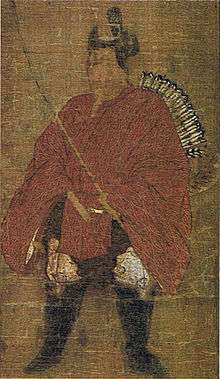Minamoto no Tameyoshi
| Minamoto no Tameyoshi | |
|---|---|
 Minamoto no Tameyoshi, from the collection of Shiramine Shrine | |
| Native name | 源為義 |
| Born | 1096 |
| Died | August 17, 1156 |
| Buried | Gongen-ji, in Sujakuurahata-chō, Shimodagyō-ku, Kyōto |
| Battles/wars | Hōgen Rebellion |
Minamoto no Tameyoshi (源 為義, 1096 – August 17, 1156) was head of the Minamoto samurai clan during his lifetime, and grandson of Minamoto no Yoshiie; he led the Minamoto in the Hōgen Rebellion. Tameyoshi is also known as Mutsu Shirō (陸奥 四郎).
Though most famous for his involvement in the Hōgen Rebellion, Minamoto No Tameyoshi is also said to have intervened in a number of other conflicts earlier in his life. Around 1113, the ongoing rivalry between the warrior monks of Mii-dera and Enryaku-ji erupted into outright violence in the streets of Kyoto. Though the palace guard mobilized quickly to protect the Emperor, it is said that Tameyoshi, with a handful of mounted samurai, drove the mobs away himself.[1]
Upon being defeated in the Hōgen Rebellion, Tameyoshi took the tonsure and was released into the custody of his son Minamoto no Yoshitomo who then had him beheaded.[1]:256 This was an unprecedented breaking of Buddhist values in Japan, yet no one in the court berated Yoshitomo for his actions at the time until after his death.
Family
- Father: Minamoto no Yoshichika (源義親, ?–1108?)
- Mother: unknown
- Wife: daughter of Fujiwara no Tadakiyo (藤原忠清の娘)
- 1st son: Minamoto no Yoshitomo (源義朝, 1123–1160)
- Concubine: daughter of Rokujō no Shigesugu (六条重俊娘)
- 2nd son: Minamoto no Yoshikata (源義賢, ?–1155)
- 3rd son: Minamoto no Yoshihiro (源義広, ?–1184), also called "Shida Saburō Senjō" (志田三郎先生).
- Concubine: daughter of Minamoto no Motosane (源基実娘)
- 4th son: Minamoto no Yorikata (源頼賢, ?–1156)
- 5th son: Minamoto no Tamekata (源頼仲, ?–1156)
- 6th son: Minamoto no Tamemune (源為宗, ?–1156)
- Concubine: daughter of Kamo no Narimune (賀茂成宗娘)
- 7th son: Minamoto no Tamenari (源為成, ?–1156)
- Concubine: 'prostitute from Eguchi-jō (江口城), Settsu Province
- 8th son: Minamoto no Tametomo (源為朝, 1139–1170)
- 9th son: Minamoto no Tamenaka (源為仲, 1142–1156)
- Children with unknown mother:
- 10th son: Minamoto no Yukiie (源行家, 1143–1186)
- 11th son: Minamoto no Otowaka (源乙若, 1144–1156)
- 12th son: Minamoto no Kamewaka (源亀若, 1146–1156)
- 14th son: Minamoto no Koreyoshi (源維義, ?–?)
- 15th son: Minamoto no Yorisada (源頼定, 1151–?)
- 17th son: Minamoto no Masachika (源正親, 1153–?)
- Son: Minamoto no Norisato (源仙覚, ?–?)
- Son: Minamoto no Takakimi (源天王, ?–?)
- Daughter: "Lady of Mino" (美濃局, ?–?)
- Daughter: Tori-in-zen-ni (鳥居禅尼, ?–?)
- Daughter: wife of Sasaki Hideyoshi (佐々木秀義室)
- Daughter: wife of Fujiwara no Mitsutaka (藤原光隆室)
- Wife: daughter of Fujiwara no Tadakiyo (藤原忠清の娘)
See also
References
- trans. Varley, Paul H. (1980). "A Chronicle of Gods and Sovereigns 'Jinnō Shōtōki' of Kitabatake Chikafusa". New York: Columbia University Press.